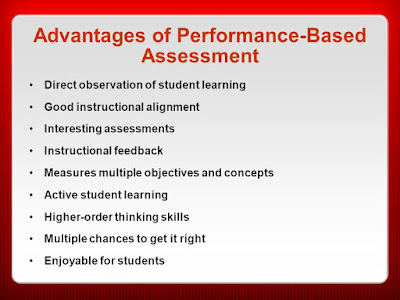Informal assessments (also called authentic or alternative) allow teachers to track the ongoing progress of their students regularly and often. While standardized tests measure students at a particular point in the year, ongoing assessments provide continual snapshots of where students are throughout the school year. By using informal assessments, teachers can target students' specific problem areas, adapt instruction, and intervene earlier rather than later.
Ongoing assessments are particularly important for English language learners (ELLs). Standardized tests in English do not usually reflect ELLs' true content knowledge or abilities. Yet informal assessments can provide a more well-rounded picture of their skills, abilities, and ongoing progress. Today's No Child Left Behind legislation requires that meticulous records be kept on the progress of ELLs. Having these records will make it easier when questions of program placement, special services, and grading arise.
There are two commonly used informal methods: performance-based assessment and portfolio assessment. Both methods utilize typical classroom activities to measure progress toward curricular goals and objectives. These activities can be monitored and recorded by teacher observation and student self-assessment.
Performance-Based Assessments
Performance-based assessments are based on classroom instruction and everyday tasks. You can use performance-based assessments to assess ELLs' language proficiency and academic achievement through oral reports, presentations, demonstrations, written assignments, and portfolios.
These assessments can include both processes (e.g., several drafts of a writing sample) and products (e.g., team projects). You can use scoring rubrics and observation checklists to evaluate and grade your students. These assessment tools can help document your ELLs' growth over a period of time.
A language and academic assessment form can be completed on a monthly basis to learn about the overall academic and English proficiency progress of your ELLs. If there is an ESL or resource teacher at school assisting your ELLs, you can share this assessment of the ELL's progress during the past month.
When using performance-based assessments, it is important to establish clear and fair criteria from the beginning. It might be helpful to develop these criteria in conjunction with other teachers or specialists at your school. Performance-based assessments promote a wide range of responses and do not typically produce one single, correct answer. Therefore, evaluation of student performances and products must be based on teacher judgment, using the criteria specified for each task. For instance, an oral scoring rubric is very useful for this type of assessment.
You can also develop assessment (and instructional) activities that are geared to your ELLs' current level of English proficiency. Performance-based assessment activities can concentrate on oral communication and/or reading. Here are examples of commonly-used activity types designed for assessing speaking or reading:
- Reading with partners
- Retelling stories
- Role-playing
- Giving descriptions or instructions using visual or written prompts
- Oral reporting to the whole class
- Telling a story by using a sequence of three or more pictures
- Completing dialogue or conversation through written prompts
- Debating, either one-on-one or taking turns in small groups
- Brainstorming
- Completing incomplete stories
- Playing games
When using performance-based assessments with beginner and intermediate English proficiency level ELLs, it is best to assess no more than three items at a time. For example, in one role-play activity, you might assess ELLs' abilities to:
- Respond to "what" and "where" questions
- Ask for or respond to clarification
- Read addresses or telephone numbers
Portfolio Assessments
Portfolios are practical ways of assessing student work throughout the entire year. With this method, you can systematically collect descriptive records of a variety of student work over time that reflects growth toward the achievement of specific curricular objectives. Portfolios include information, sample work, and evaluations that serve as indicators of student performance. By documenting student performance over time, portfolios are a better way to crosscheck student progress than just one measure alone. Portfolios can include:
- Samples of written student work, such as stories, completed forms, exercise sheets, and descriptions
- Drawings representing student content knowledge and proficiencies
- Tapes of oral work, such as role-playing, presentations, or an oral account of a trip
- Teacher descriptions of student accomplishments, such as performance on oral tasks
- Formal test data, checklists, and rating sheets
Checklists or summary sheets of tasks and performances in the student's portfolio can help you make instructional decisions and report consistently and reliably. Checklists can also help you collect the same kind of data for each student. In this way, you can assess both the progress of one student and of the class as a whole. A math development checklist is an example of how you can organize your data collection for each ELL.
In addition, here are a few ways that your ELLs can have an active role in the portfolio process:
- Students can select samples of their work and reflect on their own growth over time.
- You can meet with ELLs to develop their goals and standards, such as with a writing criteria chart.
- Together with students, you can set tangible, realistic improvement goals for future projects.
- Students – as a class, in groups, or individually – can create their own rubrics.

















